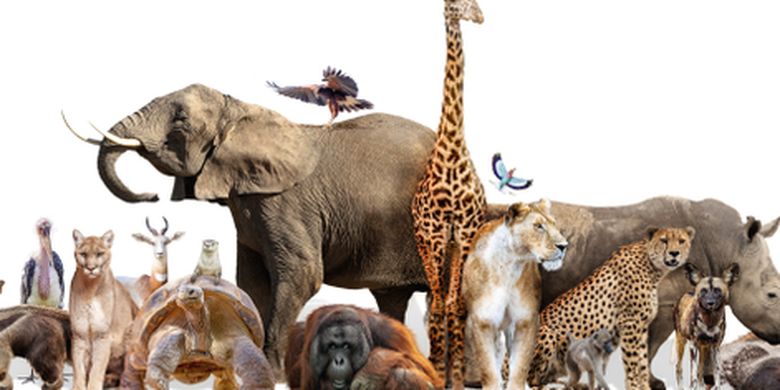KOMPAS.com – Humans, animals and plants, depend on each other. Do you know anything animal benefits for the environment as well as for humans?
Check out the various benefits of animals for the environment:
Food Sources
Animals are a source of food for humans besides plants. Animals provide complete amino acid proteins for human growth and development.
Examples of foods that are sourced from animals are red meat, white meat, animal oil, and milk.
Some plants are even classified as carnivores and prey on insects such as the Venus flytrap and semar pockets.
Clothing Material
Reporting from ThoughtCo., animal skins have been made into clothing that warms humans since 100,000 to 500,000 years ago.
Also read: Human Transportation Equipment, Starting from Animals
Clothing made of animal skins and fur maintains the temperature of the human body so that it can survive cold weather.
In this day and age, animal skins and fur are still used in fashion as clothes, robes, jackets, shoes, bags, and wallets.
Consumers in the Food Chain
Animals are consumers who eat plants or even other animals in the food chain.
In the absence of animals, producers such as plants will live very fertile and uncontrollably so that they can invade human habitation.
Illustration of bee sucking nectar on flower.-Pollination of Plants
Butterflies, birds, and also bees are animals that can help pollinate plants.
Without these animals some plants such as blueberries, flowers, and wild plants cannot reproduce and grow.
Decomposers
Do you know where the bodies of dead living beings go? When humans die, they will be buried as well as pets.
But what about wild animals? How can carcasses disappear from the Earth’s surface without accumulating and spreading odors here and there?
The answer is the existence of decomposers or decomposers. Reporting from National Geographic, decomposers are animals or microorganisms that break down the carcass of living things and break them down into molecules that can be absorbed by the environment.
Also read: Fossil Fuel: Petroleum, Coal, and Natural Gas
Decomposers break down the dead bodies of living things into basic substances such as water, carbon, nitrogen, phosphorus, nitrogen and other gases.
The basic substances are then reabsorbed by living things to grow and develop. Examples of decomposers are protozoa, bacteria, fungi, earthworms, millipedes, termites, maggots.
Fertilizer Producer
Animal manure is naturally used as fertilizer by plants. Animal waste is broken down by decomposers into substances needed by plants such as nitrogen.
This is why plants that live side by side with animals can thrive without human intervention.
Tracking Animals
Dogs and mice are known to have a sharper sense of smell than humans. Reporting from GlobalGiving, rats are used to detect landmines because they have a sharp smell.
Mice were even rated as more efficient at detecting landmines than metal detectors which were expensive and endangering the life of their operators, as well as sniffer dogs, which were more powerful than mice.
Also read: Dove Becomes a Symbol of Letter Delivery
Reporting from BBC, dogs have been helping humans since 20,000 years ago in hunting, herding and self-defense activities.
Until now, dogs remain loyal companions to humans. Bloodhounds can help locate victims of natural disasters, missing people, and track various items to help human problems and solve criminal cases.
Improve Human Health
Reporting from Center for Disease Control and Prevention (CDC), raising animals can reduce blood pressure, cholesterol levels, blood sugar levels, feelings of loneliness, and improve socialization in humans.
Pets can even help children with autism to socialize with their surroundings.
– .
Butterflies, birds, and also bees are animals that can help pollinate plants.
Without these animals some plants such as blueberries, flowers, and wild plants cannot reproduce and grow.
Decomposers
Do you know where the bodies of dead living beings go? When humans die, they will be buried as well as pets.
But what about wild animals? How can carcasses disappear from the Earth’s surface without accumulating and spreading odors here and there?
The answer is the existence of decomposers or decomposers. Reporting from National Geographic, decomposers are animals or microorganisms that break down the carcass of living things and break them down into molecules that can be absorbed by the environment.
Also read: Fossil Fuel: Petroleum, Coal, and Natural Gas
Decomposers break down the dead bodies of living things into basic substances such as water, carbon, nitrogen, phosphorus, nitrogen and other gases.
The basic substances are then reabsorbed by living things to grow and develop. Examples of decomposers are protozoa, bacteria, fungi, earthworms, millipedes, termites, maggots.
Fertilizer Producer
Animal manure is naturally used as fertilizer by plants. Animal waste is broken down by decomposers into substances needed by plants such as nitrogen.
This is why plants that live side by side with animals can thrive without human intervention.
Tracking Animals
Dogs and mice are known to have a sharper sense of smell than humans. Reporting from GlobalGiving, rats are used to detect landmines because they have a sharp smell.
Mice were even rated as more efficient at detecting landmines than metal detectors which were expensive and endangering the life of their operators, as well as sniffer dogs, which were more powerful than mice.
Also read: Dove Becomes a Symbol of Letter Delivery
Reporting from BBC, dogs have been helping humans since 20,000 years ago in hunting, herding and self-defense activities.
Until now, dogs remain loyal companions to humans. Bloodhounds can help locate victims of natural disasters, missing people, and track various items to help human problems and solve criminal cases.
Improve Human Health
Reporting from Center for Disease Control and Prevention (CDC), raising animals can reduce blood pressure, cholesterol levels, blood sugar levels, feelings of loneliness, and improve socialization in humans.
Pets can even help children with autism to socialize with their surroundings.
– .


